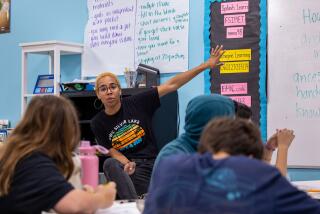Lessons in survival -- for preschoolers
CHICAGO — From passionate stories of imaginary friends to bed-jumping and play dates gone awry, preschool teachers are often amused by the tales their students tell in school.
But in Marisol Sierra’s classes at McKinley Park Elementary School, the stories told by 4- and 5-year-olds often have startling twists. They talk about riding their bicycles and playing house. But they also bring up “los gang bangers” and how to avoid getting shot.
“Bad boys” come out at night in their neighborhoods, her students say, and when they hear gunfire at night they know they may awaken the next morning with another example, often firsthand, of the damage that guns do.
“They whack people,” said Joshua Zepeda, 5. “Guns kill people and you can die.”
With several Chicago Public Schools students killed by gunfire this year, Sierra has had to update her curriculum to include lessons that could mean life or death to her pupils.
“Every day the children were talking, saying, ‘Teacher, there was a gang fight by my house.’ ‘Teacher, on the news a boy got shot,’ ” Sierra said. “So we started talking about some ways to be safe.”
Her work earned her a 2008 Kohl McCormick Early Childhood Teaching Award.
Lou Bank, vice president of the Dolores Kohl Education Foundation, said early childhood education experts visited Sierra’s class three times and interviewed her and others about her work. The group praised her skill at teaching the academics needed to ready students for kindergarten, and was impressed with her decision to discuss topics other teachers wouldn’t dare to bring up with such young students.
“You don’t want children scared for their lives -- they need to feel safe,” Bank said. “She makes them feel safe and still lets them know there are concerns.”
Before students in each of Sierra’s two preschool classes begin reciting nursery rhymes and learning reading skills, they gather on a colorful rug around Sierra, who points to a large sheet of paper bearing the signatures of the 20 students in each class.
The paper is a contract. A red line runs through a student’s drawing of a gun above a promise that he or she won’t “touch real guns or talk to gangs.”
The promise helps Sierra get her students to talk about how to cope with the violence. The children gather around and immediately start talking about the latest run-ins they and their families have had with gang members.
“I was riding by my home and I saw some gang bangers on my street and they were fighting. I got on my bike and I ride fast, and then I got back to my home and I got inside,” said Aldo Gonzalez, 5.
As Aldo spoke, the other children joined in, recounting similar experiences.
“We tell our moms and we call the 911 emergency. . . . Do we stay there to watch?” Sierra asked.
“No!” the students shouted.
Sierra knows daily conversations aren’t the answer to the problem of gangs and guns on Chicago’s streets, but she also knows she must teach her pupils how to stay alive. That means staying away from gang members who try to talk to them and never touching a gun.
Learning to stay away from guns is especially important because several students have said relatives have them in their homes for protection.
Although parents of many of the students said they wished their children didn’t have to be exposed to such talk, they support Sierra. The earlier children can learn about the perils of guns and gangs, the better it is for them, they say.
Andres Zepeda, a Chicago police officer whose son Joshua is in the class, said gang members were getting younger. He has arrested some as young as 12. Parents and teachers have an obligation to talk about crime before students distance themselves from their parents, he said.
“She’s teaching them something that we should be teaching kids now at a younger age,” he said. “You get them now, and I don’t have to deal with them later.”
More to Read
Sign up for Essential California
The most important California stories and recommendations in your inbox every morning.
You may occasionally receive promotional content from the Los Angeles Times.










